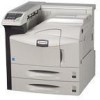Kyocera 9530DN Operation Guide - Page 10
Selecting the Right Paper, Condition, Composition, Paper Sizes, MP tray, Cassette or - laser printer
 |
View all Kyocera 9530DN manuals
Add to My Manuals
Save this manual to your list of manuals |
Page 10 highlights
Handling Paper Selecting the Right Paper Laser printing is a process involving laser light, electrostatic discharge, toner, and heat. In addition, as the paper passes through the printer it undergoes considerable sliding, bending, and twisting motions. A highquality printing paper matching the printer's requirements withstands all these stresses, enabling the printer to turn out clean, crisp printed copies consistently. Remember that all paper is not the same. Some of the factors to consider when selecting paper for the printer are as follows: Condition Avoid using paper that is bent at the edges, curled, dirty, torn, embossed, or contaminated with lint, clay, or paper shreds. Use of paper in these conditions can lead to illegible printing, misfeeding, and paper jams, and can shorten the life of the printer. In particular, avoid using paper with a surface coating or other surface treatment. The paper should have as smooth and even a surface as possible. Composition Do not use paper that has been coated or surface-treated and contains plastic or carbon. The heat of fusing can cause such paper to give off harmful fumes. Bond paper should contain at least 80 % pulp. Not more than 20 % of the total paper content should consist of cotton or other fibers. Paper Sizes Cassettes and an MP tray are available for the paper sizes listed in the table below. The dimensional tolerances are ±0.7 mm (±0.0276 inches) for the length and width. The angle at the corners must be 90° ±0.2°. MP tray Envelope Monarch Envelope #10 Envelope #9 Envelope #6 Envelope DL Envelope C5 A6 B6 Size 3-7/8 × 7-1/2 inches Cassette or MP tray Size Ledger 11 × 17 inches 4-1/8 × 9-1/2 inches 3-7/8 × 8-7/8 inches 3-5/8 × 6-1/2 inches 110 × 220 mm 162 × 229 mm 105 × 148 mm 128 × 182 mm Legal Letter Statement Folio A3 A4 A5 8-1/2 × 14 inches 8-1/2 × 11 inches 5-1/2 × 8-1/2 inches 210 × 330 mm 297 × 420 mm 210 × 297 mm 148 × 210 mm 1-4 ADVANCED OPERATION GUIDE















